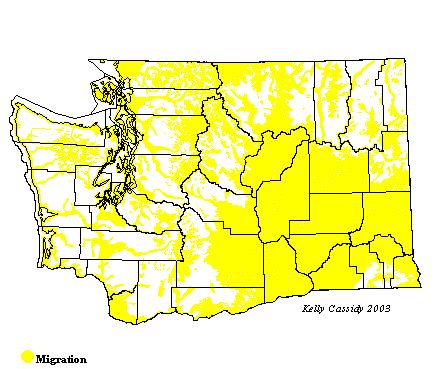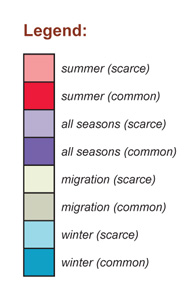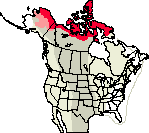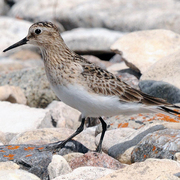Baird's Sandpiper
General Description
Baird's Sandpipers are brown shorebirds with black legs and very long wings. Their medium-length bills are fine-tipped and straight. Adults in breeding plumage are light brown, and have black spots on their wings. Non-breeding adults are gray-brown, and lack spots. The juvenile, the most common form found in Washington, is brown with white-edged feathers that give it a scaly appearance. In flight, it shows white wing-stripes and a dark line down the middle of its tail, with white on either sides of the rump.
Habitat
Breeding habitat is dry upland tundra. During migration, Baird's Sandpipers can be found along sandy shores and sometimes mudflats. They prefer higher, drier habitat than most other small sandpipers. They are also likely to be found in alpine areas, at high-elevation lakes, or even on snow banks. Wintering grounds are southern South American grasslands.
Behavior
Baird's Sandpipers are generally found individually or in small flocks. Flock size can be greater mid-continent where they are more common. Baird's Sandpipers typically forage along the upper edge of mudflats, or up on sandy beaches, often in vegetation. They will sometimes forage in the water, but not regularly. Birds in the mountains will feed on snow banks. They move quickly with heads up, picking up surface prey.
Diet
Baird's Sandpipers are primarily insect-eaters.
Nesting
The nest is located on the ground among rocks and perhaps in low ground cover, sometimes well hidden in a grass clump. The male builds most of the nest, which is a shallow scrape lined with lichen, grass, and leaves. Both parents help incubate the four eggs for 19 to 22 days. The young leave the nest soon after hatching and feed themselves. Both parents brood and tend the young at first, but the female usually abandons the brood before they fledge. The male stays with the brood until they begin to fly, at 16 to 20 days.
Migration Status
These long-distance migrants travel up and down the interior of North America. Females head south slightly ahead of the males, and many birds congregate in the Great Plains and the central valleys of Mexico before flying nonstop to southern South America.
Conservation Status
The Canadian Wildlife Service estimates the population of Baird's Sandpipers at 300,000 birds. This species' use of the Arctic National Wildlife Refuge, as well as major migration staging areas, makes it vulnerable if these areas are lost or degraded.
When and Where to Find in Washington
Baird's Sandpipers are uncommon migrants in Washington, usually seen during fall migration. They are rare from mid-April to late May; those that do pass through in spring are more common east of the Cascades. Most of the Baird's Sandpipers in Washington, however, are juveniles seen in fall. Fall birds may be seen in Washington as early as late June, but they are rare until early August. On the coast, at places such as Ocean Shores, they are most likely from early August through September, although some late stragglers may be seen into October. Inland, they are uncommon as early as July, but are more common from August through mid-September. They become less common through the end of September, and are rarely seen through October. Good inland spots are the Walla Walla River delta and Rock Lake.
 Abundance
Abundance
| Ecoregion | Jan | Feb | Mar | Apr | May | Jun | Jul | Aug | Sep | Oct | Nov | Dec |
|---|---|---|---|---|---|---|---|---|---|---|---|---|
| Oceanic | ||||||||||||
| Pacific Northwest Coast | R | U | U | R | ||||||||
| Puget Trough | R | R | ||||||||||
| North Cascades | R | R | ||||||||||
| West Cascades | U | U | ||||||||||
| East Cascades | R | |||||||||||
| Okanogan | U | U | ||||||||||
| Canadian Rockies | F | F | ||||||||||
| Blue Mountains | ||||||||||||
| Columbia Plateau | R | F | R |
Washington Range Map

North American Range Map


Family Members
 Spotted SandpiperActitis macularius
Spotted SandpiperActitis macularius Solitary SandpiperTringa solitaria
Solitary SandpiperTringa solitaria Gray-tailed TattlerTringa brevipes
Gray-tailed TattlerTringa brevipes Wandering TattlerTringa incana
Wandering TattlerTringa incana Greater YellowlegsTringa melanoleuca
Greater YellowlegsTringa melanoleuca WilletTringa semipalmata
WilletTringa semipalmata Lesser YellowlegsTringa flavipes
Lesser YellowlegsTringa flavipes Upland SandpiperBartramia longicauda
Upland SandpiperBartramia longicauda Little CurlewNumenius minutus
Little CurlewNumenius minutus WhimbrelNumenius phaeopus
WhimbrelNumenius phaeopus Bristle-thighed CurlewNumenius tahitiensis
Bristle-thighed CurlewNumenius tahitiensis Long-billed CurlewNumenius americanus
Long-billed CurlewNumenius americanus Hudsonian GodwitLimosa haemastica
Hudsonian GodwitLimosa haemastica Bar-tailed GodwitLimosa lapponica
Bar-tailed GodwitLimosa lapponica Marbled GodwitLimosa fedoa
Marbled GodwitLimosa fedoa Ruddy TurnstoneArenaria interpres
Ruddy TurnstoneArenaria interpres Black TurnstoneArenaria melanocephala
Black TurnstoneArenaria melanocephala SurfbirdAphriza virgata
SurfbirdAphriza virgata Great KnotCalidris tenuirostris
Great KnotCalidris tenuirostris Red KnotCalidris canutus
Red KnotCalidris canutus SanderlingCalidris alba
SanderlingCalidris alba Semipalmated SandpiperCalidris pusilla
Semipalmated SandpiperCalidris pusilla Western SandpiperCalidris mauri
Western SandpiperCalidris mauri Red-necked StintCalidris ruficollis
Red-necked StintCalidris ruficollis Little StintCalidris minuta
Little StintCalidris minuta Temminck's StintCalidris temminckii
Temminck's StintCalidris temminckii Least SandpiperCalidris minutilla
Least SandpiperCalidris minutilla White-rumped SandpiperCalidris fuscicollis
White-rumped SandpiperCalidris fuscicollis Baird's SandpiperCalidris bairdii
Baird's SandpiperCalidris bairdii Pectoral SandpiperCalidris melanotos
Pectoral SandpiperCalidris melanotos Sharp-tailed SandpiperCalidris acuminata
Sharp-tailed SandpiperCalidris acuminata Rock SandpiperCalidris ptilocnemis
Rock SandpiperCalidris ptilocnemis DunlinCalidris alpina
DunlinCalidris alpina Curlew SandpiperCalidris ferruginea
Curlew SandpiperCalidris ferruginea Stilt SandpiperCalidris himantopus
Stilt SandpiperCalidris himantopus Buff-breasted SandpiperTryngites subruficollis
Buff-breasted SandpiperTryngites subruficollis RuffPhilomachus pugnax
RuffPhilomachus pugnax Short-billed DowitcherLimnodromus griseus
Short-billed DowitcherLimnodromus griseus Long-billed DowitcherLimnodromus scolopaceus
Long-billed DowitcherLimnodromus scolopaceus Jack SnipeLymnocryptes minimus
Jack SnipeLymnocryptes minimus Wilson's SnipeGallinago delicata
Wilson's SnipeGallinago delicata Wilson's PhalaropePhalaropus tricolor
Wilson's PhalaropePhalaropus tricolor Red-necked PhalaropePhalaropus lobatus
Red-necked PhalaropePhalaropus lobatus Red PhalaropePhalaropus fulicarius
Red PhalaropePhalaropus fulicarius

